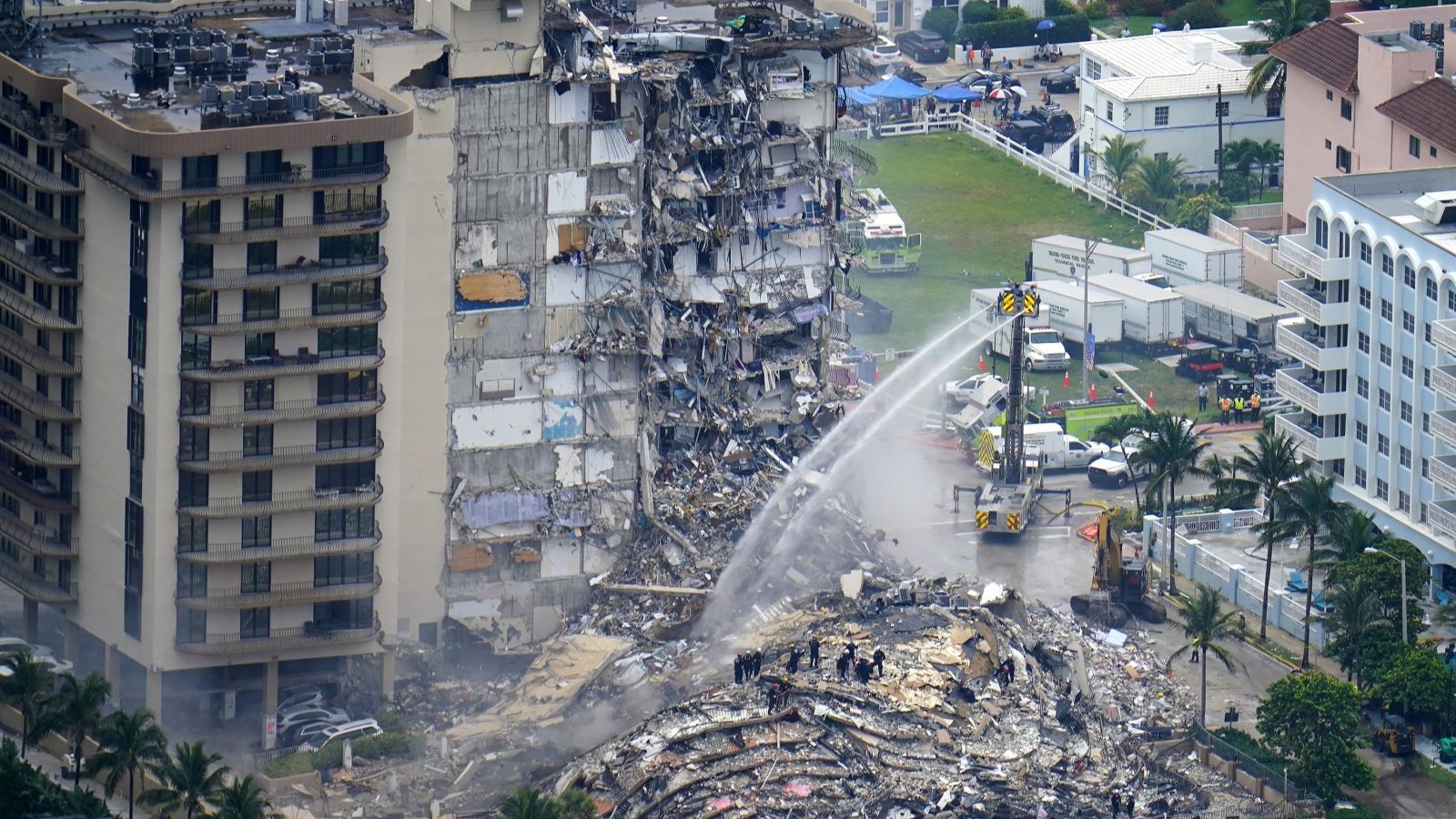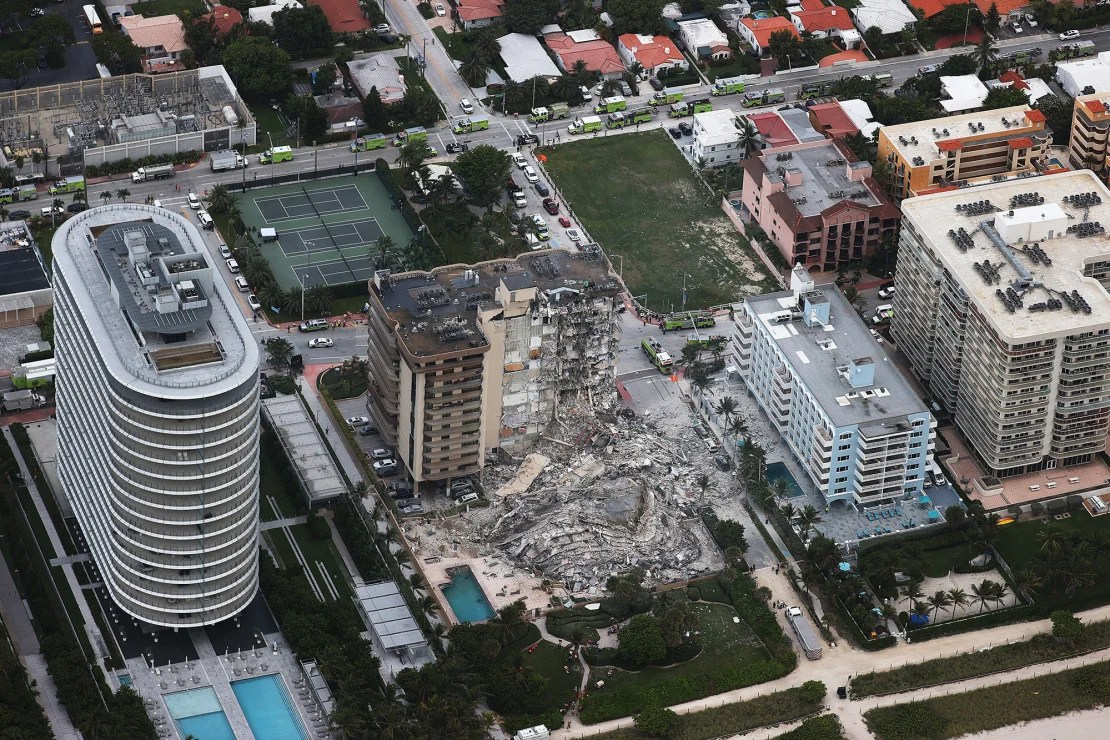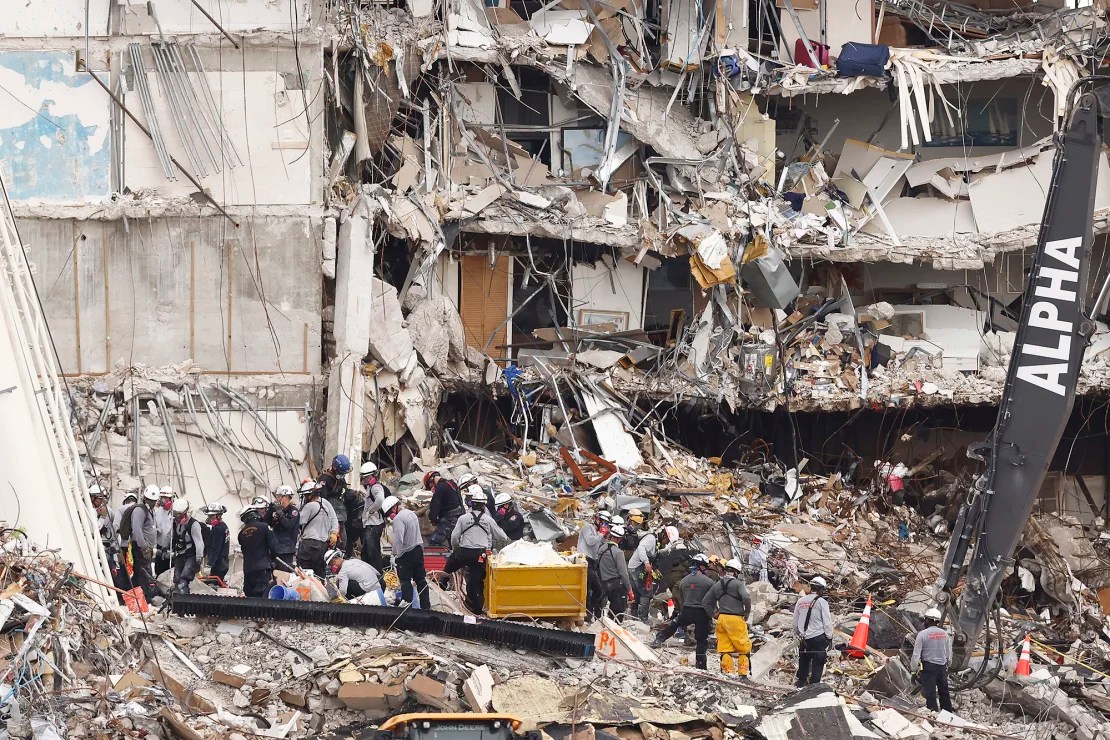(CNN) — Federal investigators on Thursday shared updates on their investigation into the cause of the catastrophic 2021 condominium collapse in Surfside, Florida, providing key information about the factors that led to the deaths of 98 people under the rubble.
Researchers identified hundreds of potential flaws in the building, ultimately narrowing down two dozen hypotheses about what might have triggered the collapse, National Standards and Technology Institute officials said in a presentation on their progress.
The building's pool deck, located at ground level above the underground parking garage, collapsed at least four minutes before the rest of the building, confirming earlier witness reports, the investigation revealed. Possible structural failures in the pool deck or in columns supporting the tower are among the main issues now being analyzed as teams investigate the cause of the disaster, investigators said.
A portion of the Champlain Towers South building collapsed in the predawn hours of June 24, 2021, turning the once-thriving apartment building into a devastating sight, crushing or trapping residents under a huge pile of metal.

Rescue workers search through the remains of the Champlain Towers South condo building in Surfside, Florida on June 25, 2021. (Gerald Herbert/AP)
It took search and rescue teams approximately one month to locate and identify the 98 victims, ranging in age from 1 to 92. The tragedy affected families around the world, including those from Argentina, Paraguay and Colombia. In some cases, entire families died.
Tragedy can be decades in the making. Investigators have determined that Champlain Towers' integrity may have been compromised when it was built in the 1970s, noting that the design and construction of parts of it did not meet standard building code requirements at the time.
But the search for answers is far from over, as investigators must continue to scrutinize evidence and rule out a long list of possible scenarios. Its final results are expected to be published in a report next year.
The agency investigates major building failures and disasters, including the World Trade Center on 9/11, but does not determine criminal culpability. Instead, it can recommend changes to building codes to improve future safety standards.
CNN has reached out to Surfside city officials for comment.
These are the key takeaways from Thursday's research update.
Parts of the original building are not up to code, investigators say
When construction on Champlain Towers was completed in 1981, parts of its structural design did not meet building code requirements, particularly in the pool deck and tower columns, investigators said in their presentation.
“We found many places where the construction did not meet the requirements of the plans, building code or general practice,” said James Harris, one of the project leaders.
According to the presentation, deficiencies were found in the strength of the building's steel reinforcements, concrete alignment and columns, and floor concrete. Officials noted “severe” strength deficiencies in several areas of the pool.
A few months before the collapse, the building underwent major structural repairs. Condo association president Jean Wodnicki outlined some of the issues in an April 2021 letter to homeowners, noting that “deterioration of concrete is accelerating.”
At the time of the collapse, the condo association approved an estimate detailing $15 million worth of repairs, a process that began more than two years after receiving reports of “major structural damage” to the building, CNN reported.

Search and rescue crews work following the partial collapse of the Champlain Towers South condo building in Surfside, Florida on June 24, 2021. (Joe Radle/Getty Images)
The pool floor sinks minutes before the building collapses
Before the chaos erupted, one resident said he was woken up by a family member concerned about “metallic noises” echoing through the building, and moments later saw the pool floor fall onto the underground garage below. Leads efforts to gather evidence for investigations.
According to investigators, the slab supporting the pool floor collapsed more than four minutes before the tower collapsed. They said the connection between the slab and its support columns may have failed, causing the slab to fall into the garage.
“There were signs of severe damage to the pool floor at least three weeks before the collapse,” investigators said in a presentation.
Residents had reported hearing “crashing” and “hammering” sounds prior to the incident, which could indicate the slab reinforcement had broken, he said. Evidence has also revealed that the slab has collapsed and corroded in water in some areas.
Over time, the plants adorning the pool deck were loaded with more infill and pavement than originally designed, according to the presentation, increasing the weight load on the slab.
Together, these shortcomings created “critically low margins against failure” during the collapse, he said.
However, the researchers noted, “there is strong evidence that the collapse started at the pool deck, and we have not yet ruled out a failure somewhere in the tower” that may have occurred before the pool collapsed.
Failure of tower columns is also possible
The researchers said they found several scenarios where the columns supporting the southern edge of the tower may have failed, forcing them to distribute their load elsewhere.
Signs of the impending disaster can be seen in video footage showing “severe structural movements” in the tower before the fall, and a roar and boom can be heard in one of the upper floor hallways before it sinks to the ground and begins to disintegrate, according to researchers.
Investigators said the initial structural failures responsible for the east side of the collapse likely occurred below the third floor, with video footage showing the building's facade moving “uniformly downward” during the collapse.
The presentation noted that the tower's columns could have been compromised in a number of ways, including corrosion, exposure to water and poor installation.
There are dozens of other hypotheses

Search and rescue teams search for survivors of the partially collapsed Champlain Towers South condominium building in Surfside, Florida on June 30, 2021. (Michael Reeves/Getty Images)
Although the researchers say they have found strong evidence to support possible causes of the decline, they have yet to rigorously rule out dozens of other hypotheses through detailed analysis and testing of the evidence.
Other possible, but less likely, are that the foundations were placed unevenly or were set on top of the terrain, causing them to sink or create other weaknesses, officials said.
Once the investigation is complete, the National Institute of Standards and Technology plans to publish a multi-volume final report on its findings and a public-friendly online presentation in the fall of 2025.
“There are millions of high-rise condominium units in Florida alone; many in older structures near the ocean,” their website states. “While the NIST investigation aims to identify the cause of the Champlain Towers South collapse, it may also uncover problems in other similar buildings nearby and around the country.”
The report may provide much-needed answers to families of victims who have seen important protections and legal remedies, but who have waited years for clarity on why this tragedy happened in the first place.
CNN's Jamiel Lynch, Nouran Salahieh and Joe Sutton contributed to this report.

“Music ninja. Analyst. Typical coffee lover. Travel evangelist. Proud explorer.”

:quality(85)/cloudfront-us-east-1.images.arcpublishing.com/infobae/TEQF6EONZRFGLLLDIDD4L2O4EE.jpg)

:quality(75)/cloudfront-us-east-1.images.arcpublishing.com/elcomercio/XU32LRAEZFDDPNVHLFU3CKVBYY.jpg)


More Stories
Earthquake in the US today, Wednesday, May 29 – Earthquake’s exact time, magnitude and location via USGS | USGS | composition
President Arrivalo is left with no alternatives to dismissing the Attorney General
Passenger dies after jumping off world’s largest cruise ship in Florida